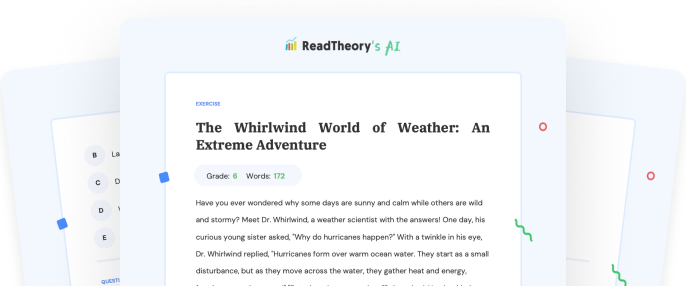Transform Your Teaching
with AI-Powered Worksheets
With ReadTheory’s Instant Worksheet Builder, you can create engaging, grade-appropriate worksheets tailored to your students in minutes. Spark curiosity, save time, and empower critical thinking with AI-powered tools designed for teachers like you.


The Art of Debate: A Battle of Words
In the heart of Hamilton High, a riveting school debate was underway. Our protagonist, timid Tim, was known to 'stammer' in front of large crowds. His rival, boastful Benny, was infamous for his 'harangue', often overshadowing the substance of his arguments with his loud and forceful delivery. Tim's mentor, wise Wendy, loved to 'rhapsodize' about the art of debating, often saying, 'It's not about who speaks the loudest, but who speaks the truth.' Tim, feeling the 'chagrin' after a lackluster performance in the initial rounds, decided to heed Wendy's advice. The final round arrived, and Benny tried to 'beguile' the judges with flashy but 'prosaic' arguments. Tim, however, stood tall and surprised everyone by refuting Benny's points with irrefutable facts and clever wit. He managed to 'thwart' Benny's attempt to wow the judges with style over substance.
Question 1
What does 'rhapsodize' mean in the context of the passage?
To argue
To stammer
To speak passionately about something
To beguile
To harangue
Question 2
What was the central idea of Tim's argument in the final round?
Being flashy and loud is the key to winning
Style is more important than substance
Benny is a better debater
Refuting points with facts and wit is more effective
His performance in the initial rounds was poor
Question 3
What is the meaning of 'prosaic' in the text?
Eloquent and poetic
Commonplace or dull
Witty and sharp
Loud and forceful
Confusing and complex
Question 4
Why did Tim feel chagrin after the initial rounds of the debate?
Because he won the debate
Because he was confident about his performance
Because he performed lacklusterly
Because Benny performed exceptionally well
Because Wendy scolded him
Question 5
What strategy did Benny use to beguile the judges?
Using irrefutable facts
Using clever wit
Speaking the truth
Using flashy but prosaic arguments
Stammering in front of the crowd
 or share via
or share via

Assign the ReadTheory pretest to determine students' reading levels.

Why Teachers Love
Instant Worksheet Builder?

Tailored Content for Every Student
Craft worksheets with passages and multiple-choice questions customized to your chosen topic and grade level, ensuring relevance and engagement.

Save Hours
of Prep Time
Our AI, Lexi, generates complete worksheets—passages, questions, and answers—in minutes, freeing you to focus on teaching, not planning.

Standards-Aligned Learning
Every worksheet is designed to boost reading comprehension and critical thinking, aligning seamlessly with State Standards to help your students shine.
Personalized teaching
for personalized learning
Browse worksheets created and refined by educators using Lexi—your source for inspiration and ready-to-use resources.


ReadTheory is free for Teachers to use.
Join thousands of educators using ReadTheory for free. Sign up today and start creating in just minutes!





